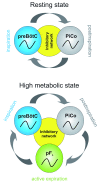Respiratory rhythm generation: triple oscillator hypothesis
- PMID: 28299192
- PMCID: PMC5310385
- DOI: 10.12688/f1000research.10193.1
Respiratory rhythm generation: triple oscillator hypothesis
Abstract
Breathing is vital for survival but also interesting from the perspective of rhythm generation. This rhythmic behavior is generated within the brainstem and is thought to emerge through the interaction between independent oscillatory neuronal networks. In mammals, breathing is composed of three phases - inspiration, post-inspiration, and active expiration - and this article discusses the concept that each phase is generated by anatomically distinct rhythm-generating networks: the preBötzinger complex (preBötC), the post-inspiratory complex (PiCo), and the lateral parafacial nucleus (pF L), respectively. The preBötC was first discovered 25 years ago and was shown to be both necessary and sufficient for the generation of inspiration. More recently, networks have been described that are responsible for post-inspiration and active expiration. Here, we attempt to collate the current knowledge and hypotheses regarding how respiratory rhythms are generated, the role that inhibition plays, and the interactions between the medullary networks. Our considerations may have implications for rhythm generation in general.
Keywords: Oscillators; Postinspiration; Respiration; breathing; networks; pacemaker; preBotzinger complex; rhythm generation.
Conflict of interest statement
Competing interests: The authors declare that they have no competing interests.No competing interests were disclosed.No competing interests were disclosed.No competing interests were disclosed.
Figures


References
Publication types
Grants and funding
LinkOut - more resources
Full Text Sources
Other Literature Sources

